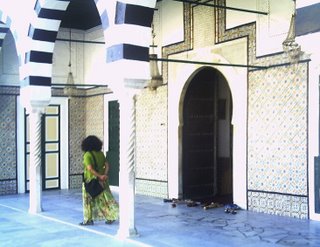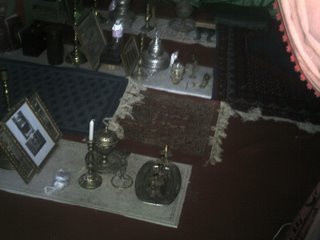Sidi Bel Hassan
 Faith
FaithI was able to visit other parts of the Sidi Bel Hassan complex in the Jellaz Cemetery in Tunis. I had visited the mosque before. Today (November 10, 2006) I was able to visit another mosque, which also contains his grave. I could look through a window at his burial site. The mosque (which, purportedly, is built over the cave where he led an ascetic’s life and had a vision of Muhammad) itself I couldn’t enter. It was Friday and an imam, dressed in white jellabah with red hat (chéchia), was sitting in the interior and others were entering to pray, leaving their shoes at the door. Before that, I had entered a long, descending cave, where the French kept Sidi Bel Hassan prisoner, without food or water. Due to his faith and prayers, food eventually appeared. To descend the passageway, I entered a room. On one side hung the flag of Algeria, a coat rack with white clothes to use as veils, and a religious calendar. I had to put on a veil to descend the all white narrow course, which ended in a rounded out cavity at the bottom.
 Only one person can enter at a time. Only women were present. I walked a short way walked down two small steps, walked a bit more, slid down to another level, which had a mihrab on the left, and stopped there. A woman was sitting on the floor, feet out in front of her, in the bottom cave, reading from the Qur’an or a prayer book. At all levels, candelabras were burning in alcoves on the right. In the bottom cavity, the alcove was in the back. I approached all areas reverently, felt the solemnity, contemplation, and, perhaps, healing or relief (at least psychological) in the air. When I ascended, an older woman, sitting on a chair across from the entrance, gave me a piece of incense (to put on the top of a chicha [water pipe]) and candles to continue my meditation at home. I was also offered some cold water, which had been blessed in the shrine. Up and down the slopes of the cemetery, I could see companions and followers of Sidi Bel Hassan, founder of the Shadhiliyya Sufi order. I was only allowed to enter these areas and take some pictures by giving a substantial donation to the guardian of the area and others working there: the woman providing the incense, a coffee and tea person, and some attendants tending a grave of another of the saint’s followers. At one point, the attendant supposedly blessed me by pressing his hands on the top of my head and then rubbing me on the insides of the elbow, the knees, and on the stomach and back. Saliva was rubbed in some of these areas as well as into my navel. So, I was introduced to some superstitions. As we walked some more, the guardian’s hands were once again placed on my head for blessing.
Only one person can enter at a time. Only women were present. I walked a short way walked down two small steps, walked a bit more, slid down to another level, which had a mihrab on the left, and stopped there. A woman was sitting on the floor, feet out in front of her, in the bottom cave, reading from the Qur’an or a prayer book. At all levels, candelabras were burning in alcoves on the right. In the bottom cavity, the alcove was in the back. I approached all areas reverently, felt the solemnity, contemplation, and, perhaps, healing or relief (at least psychological) in the air. When I ascended, an older woman, sitting on a chair across from the entrance, gave me a piece of incense (to put on the top of a chicha [water pipe]) and candles to continue my meditation at home. I was also offered some cold water, which had been blessed in the shrine. Up and down the slopes of the cemetery, I could see companions and followers of Sidi Bel Hassan, founder of the Shadhiliyya Sufi order. I was only allowed to enter these areas and take some pictures by giving a substantial donation to the guardian of the area and others working there: the woman providing the incense, a coffee and tea person, and some attendants tending a grave of another of the saint’s followers. At one point, the attendant supposedly blessed me by pressing his hands on the top of my head and then rubbing me on the insides of the elbow, the knees, and on the stomach and back. Saliva was rubbed in some of these areas as well as into my navel. So, I was introduced to some superstitions. As we walked some more, the guardian’s hands were once again placed on my head for blessing.  As I mentioned, Wassila Bourguiba is buried in the cemetery, along with members from her family. An American (1938-2002), who converted to Islam and lived in La Marsa, also has a prominent marble tomb on a hilltop, enclosed with a blue wrought iron fence.
As I mentioned, Wassila Bourguiba is buried in the cemetery, along with members from her family. An American (1938-2002), who converted to Islam and lived in La Marsa, also has a prominent marble tomb on a hilltop, enclosed with a blue wrought iron fence.I am always interested in what motivates people; and spiritual faith remains a powerful force in the world today. Belief in the spiritual power and intercession of Sidi Bel Hassan is important in North Africa and especially in Tunis, where he founded his tariqa. Both the doorman at the hotel, extremely hospitable and dressed in Ottoman style dress, and the taxi driver are members of the brotherhood. In Sufi orders, often men get together for dhikr (ritualized ceremonies, the liturgy of which may include recitation, singing, instrumental music, dance, costumes, incense, meditation, ecstasy, and trance). I left bewildered by the devotion and rituals associated with the faith, but with respect for those who feel the need to find strength in coping with the problems of every day life and are searching for community and answers to the meaning of life.
The Medina
After that, I went to the medina, centered on the famous Zitouna Mosque. I walked around taking in the suqs and bought some articles. It was Friday; so at the time of the afternoon prayer, men began hastening toward the mosque dressed in their traditional style jebbas, gandouras, and chéchias or turbans. Standing in the alleyways, covered with curved roofs and lined with decorated columns, watching men in traditional clothing following the call to prayer as Muslims have been doing for centuries, I had a sense of continuity, of solidity, and of fascination in the diversity of humankind.


0 Comments:
Post a Comment
<< Home